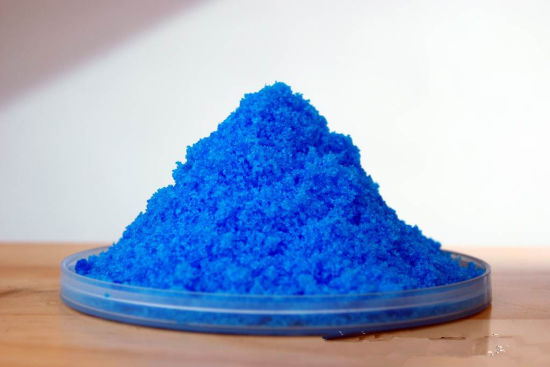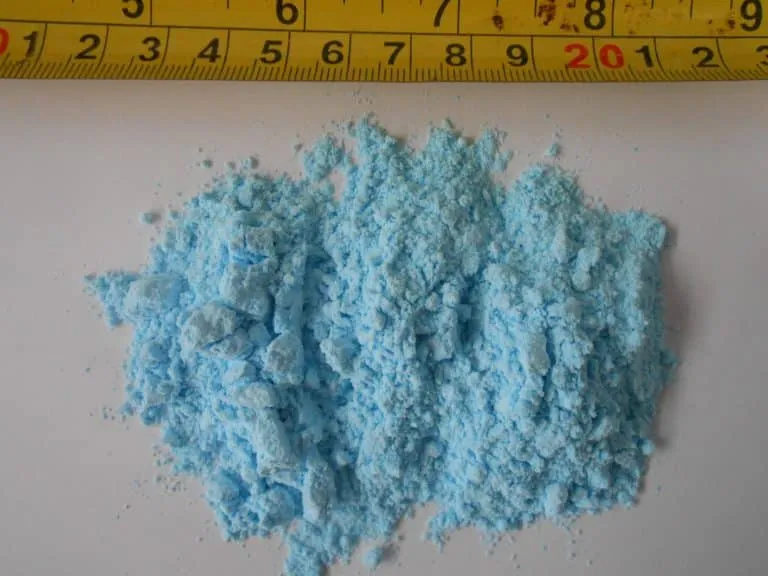Introduction
Ellman’s condensation is a well-known reaction in organic chemistry, frequently utilized for the synthesis of various compounds. A significant aspect of this process involves using catalysts to facilitate the reaction effectively. One such catalyst that has garnered attention is copper sulfate pentahydrate. This article delves into the question: Can you use copper sulfate pentahydrate for Ellman’s condensation? We will explore its role in the reaction, the science behind the process, and the advantages and potential drawbacks of using this compound as a catalyst.
What Is Ellman’s Condensation?
Ellman’s condensation is a reaction that typically involves the formation of β-lactams and other related compounds through the coupling of amines and carbonyl compounds. This reaction is crucial in pharmaceutical chemistry for synthesizing various drugs and biologically active compounds.
Mechanism of Ellman’s Condensation
The mechanism of Ellman’s condensation can be broken down into several key steps:
- Formation of the Enamine: An amine reacts with a carbonyl compound to form an enamine.
- Nucleophilic Attack: The enamine acts as a nucleophile, attacking another carbonyl compound.
- Formation of the β-Lactam: Through further cyclization and rearrangement, the β-lactam is formed.
This reaction can be catalyzed using various metal salts, and copper sulfate pentahydrate is one of the options that chemists explore.
The Role of Copper Sulfate Pentahydrate
What Is Copper Sulfate Pentahydrate?
Copper sulfate pentahydrate (CuSO₄·5H₂O) is a blue crystalline solid known for its solubility in water. It is commonly used in various fields, including agriculture, chemistry, and industry. In the context of Ellman’s condensation, it serves as a potential catalyst to facilitate the reaction.
Properties of Copper Sulfate Pentahydrate
- Solubility: It dissolves easily in water, making it accessible for various laboratory applications.
- Catalytic Activity: Copper ions can participate in redox reactions, which can be beneficial in various organic transformations.
- Cost-Effective: Copper sulfate pentahydrate is relatively inexpensive compared to other catalysts.
Can You Use Copper Sulfate Pentahydrate for Ellman’s Condensation?
The short answer is yes; copper sulfate pentahydrate can be used for Ellman’s condensation, and its effectiveness can vary depending on the specific reaction conditions. Let’s explore how it can be utilized in this context.
Experimental Considerations
When considering using copper sulfate pentahydrate for Ellman’s condensation, several factors should be taken into account:
- Concentration: The concentration of copper sulfate pentahydrate can significantly impact the reaction rate. Higher concentrations may enhance catalytic activity, but they could also lead to side reactions.
- Reaction Conditions: Temperature, pH, and solvent choice can influence the effectiveness of copper sulfate pentahydrate as a catalyst.
- Compatibility with Substrates: It’s essential to evaluate whether the substrates used in Ellman’s condensation are compatible with copper sulfate pentahydrate.
Benefits of Using Copper Sulfate Pentahydrate
- Enhanced Reaction Rates: The presence of copper ions can increase the rate of the condensation reaction, leading to higher yields.
- Improved Selectivity: Copper sulfate pentahydrate can help achieve greater selectivity in the formation of desired products, minimizing by-products.
- Sustainability: As a relatively non-toxic and abundant compound, copper sulfate pentahydrate aligns with green chemistry principles, reducing the environmental impact of chemical processes.
Potential Drawbacks
- Side Reactions: In some cases, copper ions can catalyze unwanted side reactions, leading to lower yields of the desired product.
- Complexity of Purification: The presence of copper may complicate the purification process of the final product, requiring additional steps to remove metal traces.
- Incompatibility with Certain Functional Groups: Some substrates may not react well in the presence of copper ions, necessitating careful selection of reaction partners.
Mechanism of Copper Sulfate Pentahydrate in Ellman’s Condensation
The mechanism by which copper sulfate pentahydrate facilitates Ellman’s condensation involves several steps:
- Activation of Substrates: Copper ions can interact with carbonyl compounds, increasing their electrophilicity, which enhances nucleophilic attack by the enamine.
- Stabilization of Intermediates: The copper ion may help stabilize intermediates formed during the reaction, allowing for smoother transitions between reaction stages.
- Facilitating Cyclization: Copper ions can assist in the cyclization step, promoting the formation of the β-lactam structure.
Practical Applications
Case Studies
Several studies have investigated the effectiveness of copper sulfate pentahydrate in Ellman’s condensation. These studies often highlight the catalyst’s ability to enhance yields and selectivity, making it an attractive option for organic chemists.
Comparison with Other Catalysts
Copper sulfate pentahydrate is one of many catalysts available for Ellman’s condensation. Its effectiveness can be compared to other catalysts, such as:
- Transition Metal Catalysts: While more expensive, these catalysts often provide superior selectivity and yield.
- Organocatalysts: These can offer environmentally friendly alternatives but may require longer reaction times.
Recommendations for Use
When using copper sulfate pentahydrate for Ellman’s condensation, consider the following recommendations:
- Optimize Concentration: Conduct preliminary experiments to determine the optimal concentration for your specific substrates.
- Monitor Reaction Progress: Use analytical techniques like TLC (thin-layer chromatography) to monitor reaction progress and adjust conditions as needed.
- Purification Steps: Plan purification steps to remove copper residues efficiently, such as using chelating agents.
Historical Context of Copper Sulfate Pentahydrate in Chemistry
Copper sulfate pentahydrate has been utilized in various chemical applications since the 19th century. Its catalytic properties were first noted in the context of organic reactions, leading to its exploration in different synthesis methods, including Ellman’s condensation. Historically, this compound has played a crucial role in advancing organic chemistry techniques, contributing to the development of pharmaceuticals and agrochemicals. The continued interest in its use reflects its effectiveness and the ongoing quest for efficient, cost-effective catalytic solutions in synthetic chemistry. Understanding its historical significance can provide insights into its potential applications in modern chemical research.
Environmental Impact and Green Chemistry
The growing emphasis on sustainable practices in chemistry highlights the environmental benefits of using copper sulfate pentahydrate in Ellman’s condensation. As a naturally occurring compound, copper sulfate pentahydrate presents a lower ecological footprint compared to more toxic catalysts. Its use aligns with green chemistry principles, which advocate for minimizing hazardous substances in chemical processes. By employing this catalyst, chemists can achieve significant reductions in waste and energy consumption. Additionally, the inherent biodegradability of copper compounds supports environmental safety, making copper sulfate pentahydrate an attractive option for researchers aiming to promote sustainability in their synthetic methods.
Copper Ion Coordination Chemistry
The catalytic efficiency of copper sulfate pentahydrate in Ellman’s condensation can be attributed to its unique coordination chemistry. Copper ions can form various complexes with substrates, influencing their reactivity and stability. These complexes can enhance the electrophilic character of carbonyl groups, making them more susceptible to nucleophilic attacks. The ability of copper ions to adopt multiple oxidation states also enables a range of redox processes, which can further facilitate the condensation reaction. Understanding the coordination chemistry of copper can help chemists optimize reaction conditions and design better catalytic systems, ultimately leading to improved yields and selectivity in synthesizing β-lactams.
Future Research Directions
Future research on copper sulfate pentahydrate in Ellman’s condensation holds promising potential for further optimizing its use in organic synthesis. Investigating novel reaction conditions, such as varying temperature and pressure, could enhance its catalytic performance. Additionally, exploring the synergistic effects of combining copper sulfate pentahydrate with other catalysts or co-catalysts may yield more efficient reaction pathways. Researchers could also focus on developing immobilized forms of copper sulfate pentahydrate to facilitate easier separation and recycling after reactions. Continued studies in this area may reveal new applications for this compound, reinforcing its importance in modern organic chemistry.
Conclusion
In conclusion, the question “Can you use copper sulfate pentahydrate for Ellman’s condensation?” has a positive answer. This compound offers a viable option as a catalyst for this important organic reaction. Its ability to enhance reaction rates and selectivity, coupled with its cost-effectiveness, makes it an attractive choice for chemists. However, it is crucial to consider the potential drawbacks, including side reactions and purification challenges. By optimizing reaction conditions and monitoring progress, researchers can successfully incorporate copper sulfate pentahydrate into their Ellman’s condensation protocols, contributing to more efficient and sustainable synthetic processes.
Future Perspectives
As research continues, the role of copper sulfate pentahydrate in various organic reactions, including Ellman’s condensation, may evolve. Future studies could explore novel modifications of this catalyst or combinations with other reagents to further enhance its effectiveness and minimize drawbacks. Overall, the exploration of copper sulfate pentahydrate in organic synthesis represents an exciting frontier in the field of chemistry.
FAQs
1. What is Ellman’s condensation?
Ellman’s condensation is an organic reaction that involves the coupling of amines and carbonyl compounds to form β-lactams and related compounds. This reaction is significant in pharmaceutical chemistry for synthesizing various drugs and biologically active substances.
2. How does copper sulfate pentahydrate function as a catalyst?
Copper sulfate pentahydrate acts as a catalyst by enhancing the electrophilicity of carbonyl compounds and stabilizing intermediates during the reaction. Its copper ions facilitate nucleophilic attacks and promote the cyclization process essential for forming β-lactams.
3. Are there any drawbacks to using copper sulfate pentahydrate in reactions?
While copper sulfate pentahydrate can enhance reaction rates and selectivity, potential drawbacks include the possibility of side reactions, complications in purification due to copper residues, and incompatibility with certain substrates. Careful optimization of reaction conditions can help mitigate these issues.
4. How does copper sulfate pentahydrate compare to other catalysts?
Copper sulfate pentahydrate is a cost-effective and environmentally friendly alternative to more toxic transition metal catalysts. While it may not always provide the same level of selectivity or efficiency as other catalysts, its unique properties make it a valuable option in many synthetic processes.
5. What are some future research directions for copper sulfate pentahydrate in organic synthesis?
Future research may explore optimizing reaction conditions, combining copper sulfate pentahydrate with other catalysts, and developing immobilized forms for easier separation and recycling. These investigations aim to improve its catalytic performance and broaden its applications in organic synthesis.







